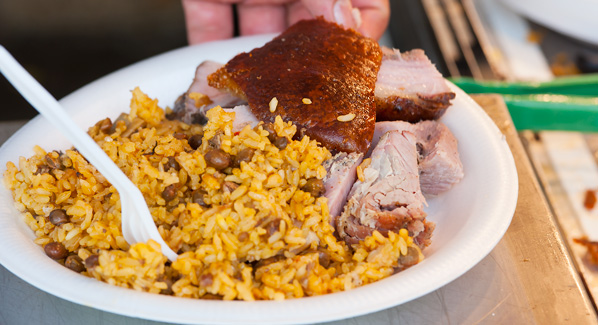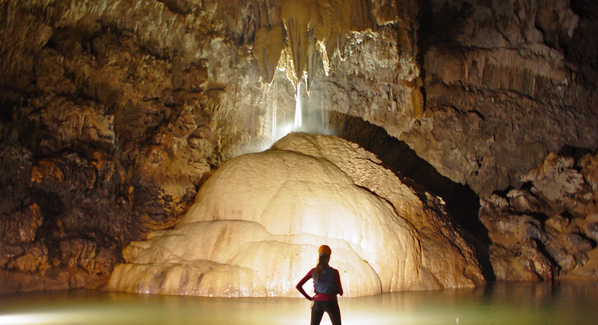When you are vacationing in the Caribbean, you’re already far outside your everyday, so why not take the next step-or several hundred of them-to widen your island experience with a hike. Tread these natural sanctuaries for encounters with local birds and wildlife, lush rainforests and sweeping panoramas of paradise. We’ve hiked the duds and the winners to give you a list of the Caribbean’s best trails—from breezy to push-the-limits challenging —winding past waterfalls, rivers, beaches, tide pools and so much more.
The Bubbly Pool Hike, Jost Van Dyke, British Virgin Islands
From Foxy’s Taboo, a popular bar and party spot on Great Harbour, the bartenders can steer you to the start of this 15- minute, super easy walk to the island’s rock-walled soaking spot. You’ll end at a pool with crashing waves sending spray overhead and a surge of bubbles up into the basin where you’re standing.
Lighthouse Footpath, Cayman Brac, Cayman Islands
Start at either end of this trail for a 90-minute walk each way past nesting grounds of brown boobies. If you make the lighthouse at the island’s easternmost point your halfway mark, pack a lunch to enjoy while sitting on limestone cliffs overlooking breaking waves. Free printed guides are available: Ask at the front desk of Brac Reef Beach Resort, or see the pamphlet in your guesthouse to arrange your hike.
The Signal Hill Tour, Antigua
Antigua’s shortest and easiest hike starts at Wallings Dam, found at the end of Fig Tree Drive. From there, it’s about an hour—if you don’t stop—to the top of Signal Hill, which rewards finishers with a 360-degree island view. If you’d like to learn more about local history and wildlife, join a tour company like Footsteps Rainforest Hiking Tours.
The Annaly Bay Tide Pool Hike, St. Croix, U.S. Virgin Islands
You won’t need fins for the tide pools at the end of this hike, but do pack a snorkel mask so you can take a cool dip and see the juvenile fish nesting in the shallows. Start this moderate, 2-mile hike behind Carambola Beach Resort and Spa. The parking-lot attendant can point you to the trailhead. It’s a fairly straightforward trail that climbs the bluffs overlooking the island’s north shore. You’ll surely stop several times to snap photos, so the uphill stretches won’t feel too strenuous.
El Toro Hike, Puerto Rico
Most visitors to El Yunque National Forest stick to the roadside pullovers immediately adjacent to waterfalls and other attractions. El Toro Trail sees few visitors despite being a moderate, well-marked 2.2-mile journey to the forest’s highest point. Wear long pants and shoes you don’t mind getting caked in mud. As for the vista, allow time to sit and enjoy the clouds rolling in.
The Sandy Cruz Trail, Saba
A visit to Saba, a satellite island of St. Maarten, is all about the cloud forest. Wait for a day when the fog has subsided around Mount Scenery, then set off on this hike. Before you go, grab a trail map from The Trail Shop at the foot of the mountain—the attendants will also keep tabs on your return. This moderate hike is the best pick for those who want to see a diversity of flora and fauna. The trail winds past banana tree groves and dense cloud forest dotted with a rainbow of orchids, and opens up to a vista overlooking the island’s airport runway, one of the world’s shortest and most adrenaline inducing.
Victoria Falls Hike, Dominica
Lose the hiking boots in favor of Tevas or similar water-ready shoes as you’ll wade across a river several times. The path can be tricky to keep track of on your own, so it’s a good idea to hire a guide for the day. Jenner Robinson of JennTours is a good pick. He’s from Dominica and has a knack for pointing out the birds of the canopy. As for the 45-minute climb, the incline isn’t too great; the challenge is staying stable atop wet rocks. But the reward is lovely. You’ll likely be the only ones admiring the 165-foot cascade of Victoria Falls.
Mount Qua Qua Trail, Grenada
Grenada is a wonderland for hikers and birders alike. The rainforest around Grand Etang Lake—what’s become of the former volcano—is home to mona monkeys, broad-winged hawks, Lesser Antillean swifts and tons of tiny frogs. A moderate pick is the Mount Qua Qua Trail, a 90-minute cruise past the lake, the elfin mountain forests and a host of canopy critters.
The Quill, St. Eustatius
It’s the jungle-covered volcanic cone that dominates the skyline from points across this small island, and it’s a gorgeous hike. The 50-minute uphill jaunt known as the Quill Trail is Statia’s most popular hike as it offers direct access to an overlook of the crater bowl. If you want to keep going, you can connect to the Crater Trail for a 90-minute circuit of the volcano’s rainforest-covered inner crater. Boven National Park also maps six other trails, all great for spying fauna like red-bellied racer snakes, Antillean iguanas, hummingbirds and more.
Nevis Peak Hike, Nevis
Steep and slippery, this hike is one worth doing with a guide, such as Lynell Liburd of Sunrise Tours. The 3,000-foot incline takes two hours to scale and two hours to pick your way down—and none of the locals call it hiking. It’s more about finding footing and grabbing hold of roots to gain ground. If it’s a clear day, you score a view of the island’s Atlantic side. Otherwise, it’s just a really satisfying workout.
























